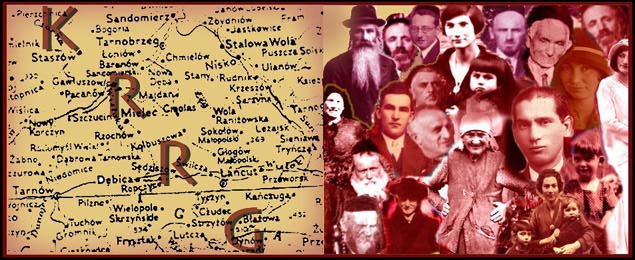


Przec³aw
Przeclaw, in 1556 mentioned as Przeczslaw, a small town in Mielec powiat,
on a sandy plain, 204 meters above sea level, on the left bank of the Wisloka,*
by the highway from Debica to Mielec. On the other side of the river, the track
of the Debica-Baranów railway (a branch of the Karl Ludwig line) passes through
the grounds of the village of Tuszyma. The town is made of wood, poorly
constructed, and has a brick parish church, a 2-class people's school, a post
office, and a gmina loan society with 963 zl. in capital. On the grounds
of the major estate stands the manor, transformed from a defensive castle, on a
precipice washed by water, as well as a still and two windmills. To the south
lies the suburb called Podzamcze, to the north Wenecya, and farther south on the
highway to Debica is the village Podole, west of which is Wólka Podolska and the
settlement Podzamcze, and west of the town is Wylów. To the north it borders on
the village of Kielków. To the east this settlement is shaded by a pine forest,
called Przeclawski bór.
There are markets in Przeclaw every Thursday. The settlement has 158 houses and
1,026 inhabitants (490 men, 536 women), 718 Roman Catholic, 9 Greek Catholic,
and 299 Jewish. On the grounds of the major estate (property of Count Mieczyslaw
Rej) are 6 houses and 135 Roman Catholic inhabitants; it has 834 mórgs of
farmland, 76 of meadows and gardens, 82 of pastures, and 1,566 of woods (see
Dobrynin). The minor estate has 672 mórgs of farmland, 77 of meadows
and gardens, 150 of pastures, and 14 of woods. The soil of the river basin is
fertile clay, but farther west it is sandy.
Przeclaw Ligeza is supposed to have founded this settlement in the 13th century
and settled it with German colonists. In the tax register of Sandomierz province
for 1566 (quoted in Pawinski, Malopolska, 500) we read: "Przeczslaw, the
small town of the noble Mikolaj Ligenza, heir to Bobrek and Przeclaw. There are
40 houses in this town, of which several are abandoned; they do not have
farmland, only several gardens, on which houses and gardens they pay rent in
various ways. The total of this rent comes to 12 grzywnas and 4 groszy.
There are no other rents. The baths pay 1½ grzywnas, the mills 2, one is
held by the heir, the other is on the Wisloka, the third, near the castle, is of
little worth; navigation on the Wisloka brings 1½ grzywnas. The soltys
has 2 lans and every 7th grosz from the rents. The castle and
grounds of the nobility (praedium) are good, there are three small ponds,
meadows, etc. There are 45 peasants who live outside the town, 5 on full lans
pay a grzywna apiece, three on ¾ lans pay 3 fertons each,
22 on half lans pay one-half grzywna each, 7 on quarter lans
pay 1 ferton each. Others have small bits of farmland on which they pay
according to their size. The total of these rents comes to 33½ grzywnas.
Two half-lan sections are abandoned. In addition the peasants give 70
measures (cherotos) of oats, 296 eggs, 57 capons, and 53 cheeses."
In 1581 the settlement on the outskirts of town belonged to the castellan of
Ropczyce (ibid., p. 248) and at that time it had 33 peasants on 11¼
lans, 5 tenants with cattle, 4 without cattle, and the town itself (ibid.,
p. 269) paid 8 zl. in a double municipal tax. There were 19 craftsmen in it, 7
settlers (inquilini), 4 distilleries (ollae cremati), as well as 1
vendor, 1 barber, 1 pauper, and 2 lans of town farmland.
The parish church, date of erection unknown, was originally of wood and called
"The Assumption of the Blessed Mother" (Dlugosz, Liber beneficiorum, II,
295). Till 1454 there were two pastors (rectores) there, from which a
great many disputes arose. Thus on 25 May 1454, after the death of pastor
Grzegorz, the Bishop and Cardinal Zbigniew Olegnicki, at the request of
Stanislaw Ligeza, Malogoszcz castellan and patron of this church, and Adam, the
one pastor, decided that thenceforth there would be one pastor there and three
mansioners, who would sing devotions of the Blessed Mother daily. In this
document, given in Liber Beneficiorum (II, 297) there is an interesting
point regarding the collection of all bequests, gifts, and incomes from burials
in a special box in the sacristy under lock and key of the squire and the
pastor. The administration of the fund was to remain under the control of the
squire. Dlugosz says that the tithe from the town was appraised at 5 grzywnas
and every mansioner had his own house to live in. Stanislaw Ligeza was to
administer this troubled fund, because from the deposit made by the late pastor
Grzegorz "he had usurped and appropriated no small sum."
In the 17th century Przeclaw produced Jan Przeclawczyk (Preklaides), theologian
and philosopher of the University of Kraków around 1630. After the Ligezas, the
Kropka-Przeclawskis owned Przeclaw, and then the Wielopolskis. Parish registers
from 1601 are preserved in the parish office. The parish belongs to Tarnów
diocese, Radomysl deanery, and includes: Blonie, Podole, Korzeniów, Tuszyma,
Bialybór, Wylów, Kadziolki, Laczki, Meciszów, Bobrowa, and Ruda. - Mac.
Source: Slownik Geograficzny Królestwa Polskiego - Warsaw [1888, vol. 9, pg. 129]
Translated by William F. Hoffman. Used with permission.
This translation first appeared in the Winter 1999 issue of "Bulletin of the Polish Genealogical Society of America".
© Copyright 2015 Kolbuszowa Region Research Group. All rights reserved.